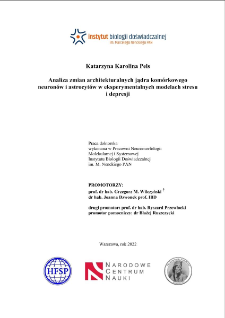
Object
Title: Analiza zmian architekturalnych jądra komórkowego neuronów i astrocytów w eksperymentalnych modelach stresu i depresji : praca doktorska
Institutional creator:
Instytut Biologii Doświadczalnej im. Marcelego Nenckiego PAN
Contributor:
Wilczyński, Grzegorz M. (1971-2020) : Supervisor ; Dzwonek, Joanna : Supervisor ; Przewłocki, Ryszard : Second supervisor ; Ruszczycki, Błażej : Assistant supervisor
Publisher:
Instytut Biologii Doświadczalnej im. M. Nenckiego PAN
Place of publishing:
Description:
159 pages : illustrations ; 30 cm ; Bibliography ; Summary in English
Degree grantor:
Instytut Biologii Doświadczalnej im. Marcelego Nenckiego PAN
Type of object:
Abstract:
The depression, according to World Health Organization is a leading cause of disability worldwide, affecting more than 270 million people. This is a multifactorial disease of still unknown pathogenesis. Unfortunately, contemporary therapies using antidepressants are not effective enough, and their therapeutic effect is usually significantly delayed. The latter fact suggests that antidepressants work by affecting long-term brain plasticity, probably associated with changes in gene activity orchestrated by reorganization of the chromatin architecture. One of the best-known pathogenic changes in depression are disturbances of the hypothalamic-pituitary-adrenal (HPA) axis regulating the release of cortisol. Cortisol, under physiological conditions, exerts a pleiotropic effect on various organs, including brain, and prepares us to "fight or flight" from danger. Nevertheless, severe stress causes disturbances in the HPA axis, which results in morphological and behavioral abnormalities. It is believed that such disruption is associated with abnormal glucocorticoid receptor (GR) function. GR regulates the activity of many genes, including the negative-feedback autoregulation of Nr3c1 gene encoding GR. Although structural changes involved in GR autoregulation on DNA level, were studies in proliferating cell, not much is known about its function in cells terminally differentiated, including neurons and astrocytes. Therefore, the presented dissertation is an attempt to investigate the architectural changes induced by GR activation in brains cells. Experiments presented in this thesis have indicated, a close relationship between activity changes of the Nr3c1 gene and its location within the cell nuclei of brain cells, under stress conditions, in three brain structures associated with the pathogenesis of depression. Application of STED super-resolution microscopy confirmed that changes in the location of the Nr3c1 gene result from its binding to active or inactive chromatin and ChIA-PET analysis clearly shown reorganization of the chromatin architecture caused by GR activation. The presented data show for a first time, that GR stimulation in brain cells leads to changes of the chromatin organization not only within this particular gene but also at the global level. And that those changes differ between neurons and astrocytes
Detailed Resource Type:
Resource Identifier:
Source:
Language:
Language of abstract:
Digitizing institution:
Nencki Institute of Experimental Biology of the Polish Academy of Sciences
Original in:
Library of the Nencki Institute of Experimental Biology PAS
Access:
Object collections:
- Digital Repository of Scientific Institutes > Partners' collections > Nencki Institute of Experimental Biology PAS
- Digital Repository of Scientific Institutes > Partners' collections > Nencki Institute of Experimental Biology PAS > Dissertations
- Digital Repository of Scientific Institutes > Partners' collections > Nencki Institute of Experimental Biology PAS > Dissertations > PhD Thesis
- Digital Repository of Scientific Institutes > Literature > Thesis
Last modified:
Dec 22, 2023
In our library since:
Oct 10, 2022
Number of object content downloads / hits:
219
All available object's versions:
https://www.rcin.org.pl/publication/272892
Show description in RDF format:
Show description in RDFa format:
Show description in OAI-PMH format:
| Edition name | Date |
|---|---|
| Pels, Katarzyna Karolina | Dec 22, 2023 |
Objects Similar
Bukowski de Bończa, Piotr
Kołodyńska-Gawrysiak, Renata Mroczek, Przemysław Chabudziński, Łukasz
Jasnowski, Paweł Piotr
Kulesza, Maria
Bączyńska, Ewa
Samborska-Kukuć, Dorota

 INSTYTUT ARCHEOLOGII I ETNOLOGII POLSKIEJ AKADEMII NAUK
INSTYTUT ARCHEOLOGII I ETNOLOGII POLSKIEJ AKADEMII NAUK
 INSTYTUT BADAŃ LITERACKICH POLSKIEJ AKADEMII NAUK
INSTYTUT BADAŃ LITERACKICH POLSKIEJ AKADEMII NAUK
 INSTYTUT BADAWCZY LEŚNICTWA
INSTYTUT BADAWCZY LEŚNICTWA
 INSTYTUT BIOLOGII DOŚWIADCZALNEJ IM. MARCELEGO NENCKIEGO POLSKIEJ AKADEMII NAUK
INSTYTUT BIOLOGII DOŚWIADCZALNEJ IM. MARCELEGO NENCKIEGO POLSKIEJ AKADEMII NAUK
 INSTYTUT BIOLOGII SSAKÓW POLSKIEJ AKADEMII NAUK
INSTYTUT BIOLOGII SSAKÓW POLSKIEJ AKADEMII NAUK
 INSTYTUT CHEMII FIZYCZNEJ PAN
INSTYTUT CHEMII FIZYCZNEJ PAN
 INSTYTUT CHEMII ORGANICZNEJ PAN
INSTYTUT CHEMII ORGANICZNEJ PAN
 INSTYTUT FILOZOFII I SOCJOLOGII PAN
INSTYTUT FILOZOFII I SOCJOLOGII PAN
 INSTYTUT GEOGRAFII I PRZESTRZENNEGO ZAGOSPODAROWANIA PAN
INSTYTUT GEOGRAFII I PRZESTRZENNEGO ZAGOSPODAROWANIA PAN
 INSTYTUT HISTORII im. TADEUSZA MANTEUFFLA POLSKIEJ AKADEMII NAUK
INSTYTUT HISTORII im. TADEUSZA MANTEUFFLA POLSKIEJ AKADEMII NAUK
 INSTYTUT JĘZYKA POLSKIEGO POLSKIEJ AKADEMII NAUK
INSTYTUT JĘZYKA POLSKIEGO POLSKIEJ AKADEMII NAUK
 INSTYTUT MATEMATYCZNY PAN
INSTYTUT MATEMATYCZNY PAN
 INSTYTUT MEDYCYNY DOŚWIADCZALNEJ I KLINICZNEJ IM.MIROSŁAWA MOSSAKOWSKIEGO POLSKIEJ AKADEMII NAUK
INSTYTUT MEDYCYNY DOŚWIADCZALNEJ I KLINICZNEJ IM.MIROSŁAWA MOSSAKOWSKIEGO POLSKIEJ AKADEMII NAUK
 INSTYTUT PODSTAWOWYCH PROBLEMÓW TECHNIKI PAN
INSTYTUT PODSTAWOWYCH PROBLEMÓW TECHNIKI PAN
 INSTYTUT SLAWISTYKI PAN
INSTYTUT SLAWISTYKI PAN
 SIEĆ BADAWCZA ŁUKASIEWICZ - INSTYTUT TECHNOLOGII MATERIAŁÓW ELEKTRONICZNYCH
SIEĆ BADAWCZA ŁUKASIEWICZ - INSTYTUT TECHNOLOGII MATERIAŁÓW ELEKTRONICZNYCH
 MUZEUM I INSTYTUT ZOOLOGII POLSKIEJ AKADEMII NAUK
MUZEUM I INSTYTUT ZOOLOGII POLSKIEJ AKADEMII NAUK
 INSTYTUT BADAŃ SYSTEMOWYCH PAN
INSTYTUT BADAŃ SYSTEMOWYCH PAN
 INSTYTUT BOTANIKI IM. WŁADYSŁAWA SZAFERA POLSKIEJ AKADEMII NAUK
INSTYTUT BOTANIKI IM. WŁADYSŁAWA SZAFERA POLSKIEJ AKADEMII NAUK


































